Xeriscape Landscape Plants & Flowers
For The Arizona Desert Environment.
Pictures, Photos, Images, Descriptions, & Reviews.
Blue Grama Grass, Bouteloua gracilis.
We Are Proud Of Our SafeSurf Rating!
Click On Any Of The Following Links By Amazon.Com
For Books, & Videos About Wildflowers Of Arizona & The Southwest USA. No Obligation!
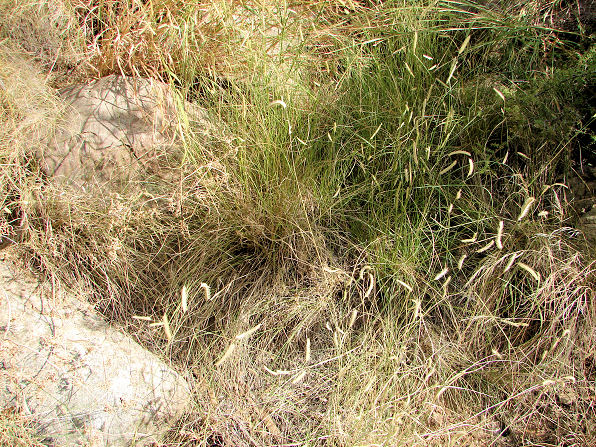 |
| Blue Grama, Bouteloua gracilis. Photo September 29, 2006. Arizona - Sonora Desert Museum. Near Tucson, Arizona. |
|---|
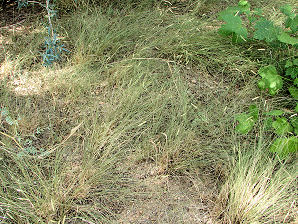 | 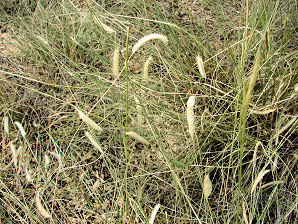 |
| Blue Grama. Bouteloua gracilis. | Blue Grama. Bouteloua gracilis. |
|---|---|
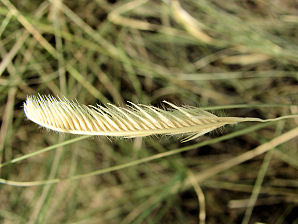 | 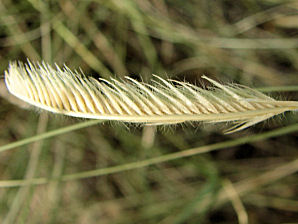 |
| Blue Grama. Bouteloua gracilis. | Blue Grama. Bouteloua gracilis. |
 /
/

Blue Grama Grass. Bouteloua gracilis, Grass Family ( Poaceae ) or ( Gramineae ), Blue Grama. Also called . We wish to thank Wikipedia, the free encyclopedia for some of the information on this page. We share images and information with Wikipedia. Blue grama grass is a tufted perennial grass. It is native to the grass prairies, making up 75% to 90% of the grasses found there. These prairies lie in central North America. Winters are cold and summers are hot. Blue grama can grow up to 20 inches tall. It grows as a bunch grass, forming open sod mats. As it matures and is grazed on by animals, the bunches grow together and form the thick sod. Blue grama is an important prairie grass because its dense, shallow root mass holds down the soil and keeps it from blowing away. It has a shallow root system so it can quickly absorb any rain that might fall. The attractive flowering branches often take on a bluish tint as they dry in the fall. It has flat leaves that come to a point at the end. The leaves can grow from 1 to 10 inches long and 1/8 inch wide. The flower stems grow 7 to 18 inches tall. The flowers look like crescents perched on the end of the flower stem. A flower consists of 20 to 90 little spikelets. Blue grama flowers from June to August, depending on what part of the prairies its growin in, and how much moisture it gets. On the prairies blue grama begins to grow late in the season, mid-April, when the soil is about 52� F (11� C). Blue grama goes dormant in the winter, and when there is a drought. Blue grama likes to grow in full sun with well-drained good soil, and can stand drought, heat, cold, and mowing. People use it instead of regular grass where there are dry areas, for grazing animals, and to control erosion. Some people use the flowers in dried flower arrangements and the plant is also used in rock gardens. The flowering heads with 1 to 3 usually curved, densely flowered, one-sided branches that terminate in a spikelet are distinctive. It has a one-sided spike up to 2 inches long that is curved and comb-shaped at maturity. Spikelets are numerous, arranged in two rows on one side of the rachis, each containing one perfect floret and two imperfect florets reduced to bristles and scales; lemmas of perfect floret three-awned; glumes hairy and awn-tipped. Habitat/Range: Blue Grama is grown throughout the Great Plains, and is found in association with buffalo grass in the short grass prairies. Blue grama is the state grass of both New Mexico, and Colorado.
Quick Notes:
Height: Height normally about 6 to 20 inches tall.
Flowers: Inflorescences of purplish - tinged flowers.
Seedhead: One-sided spike up to 2 inches long that is curved and comb-shaped at maturity. The spikelets are numerous, arranged in two rows on one side of the rachis, each containing one perfect floret and two imperfect florets reduced to bristles and scales; lemmas of perfect floret three-awned; glumes hairy and awn-tipped.
Flowering Time: Phoenix Arizona. Mid June - August.
Leaves: Simple, The blades are narrow, mostly basal, sometime curled but generally flat, 1 to 6 inches long, usually glabrous but sometimes hairy on the margin near the base, folded to slightly rolled in the bud.
Found: The USDA claims it is native to the USA (AZ, CA, CO, CT, FL, IA, ID, IL, KS, MA, ME, MI, MN, MO, MT, ND, NE, NM, NV, NY, OH, OK, SC, SD, TX, UT, WI, WY), CAN (AB, BC, MB, ON, SK). Also found in northern Mexico in the states of Baja Norte, Baja California, Chihuahua, Coahuila, Durango, Nuevo Leon, Sonora, Tamaulipas, & Zacatecas.
Hardiness:
Soil pH requirements:
Sun Exposure:
Elevation: Naturally found at about 3,500 feet up to 8,000 feet. Will grow at low elevations.
Habitat: Occurs naturally in association with Needle-and-thread, sandberg bluegrass, galleta grass, and rabbitbrush. Tolerates wide range of soil conditions from well-drained sandy soils to heavy clays. It is not found in wet, poorly drained soils. A Xeriscape Landscape plant.
Miscellaneous: Photos Taken At Arizona - Sonora Desert Museum September 29, 2006.
|



We Are Proud Of Our SafeSurf Rating!
Click On Any Of The Following Links By Amazon.Com
For Books, & Videos About Xerioscape Plants Of Arizona & The Southwest USA. No Obligation!
Back To Arizona Xeriscape Landscaping Main Page.
Back To Xeriscape Grasses Page One.
Back To Arizona Wild Flowers Home Page.
Back To DeLange Home Page
© 1966 - Present, Audrey, Eve, & George DeLange
| © 1966 - Present, Audrey, Eve, & George DeLange |


